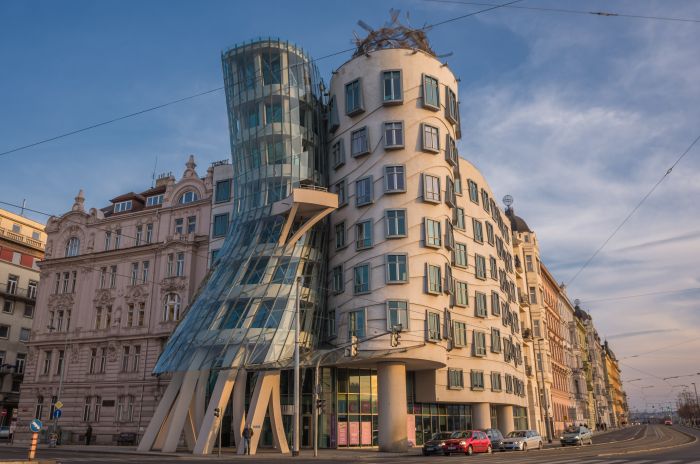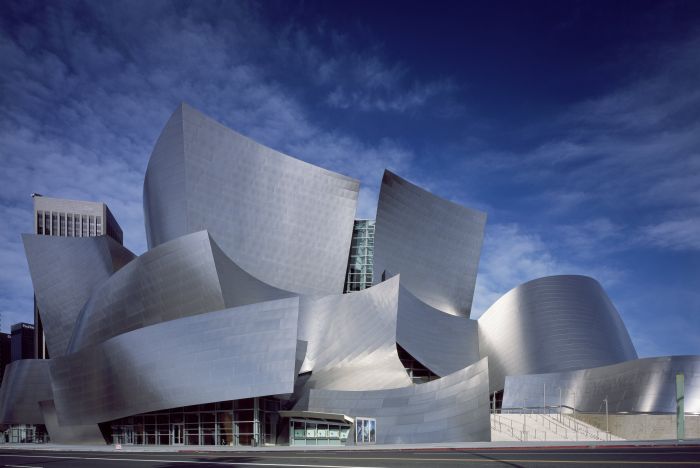Exploring Frank Gehry Architecture: A Modern Masters Influence
Frank Gehry architecture sets the stage for this enthralling narrative, offering readers a glimpse into a story that is rich in detail and brimming with originality. From his innovative use of materials to his groundbreaking designs, Gehry's impact on modern architecture is undeniable.
As we delve into the iconic buildings, materials, techniques, and influence of Frank Gehry, we uncover a world where creativity knows no bounds and architectural boundaries are continually pushed.
Introduction to Frank Gehry Architecture
Frank Gehry is renowned for his innovative and groundbreaking architectural designs that have redefined the landscape of modern architecture. His distinctive style combines abstract shapes, unconventional materials, and a sense of movement, creating structures that challenge traditional norms and push boundaries.
Impact of Frank Gehry’s Designs
Frank Gehry's designs have had a profound impact on modern architecture, inspiring a new wave of creativity and experimentation in the field. His iconic buildings, such as the Guggenheim Museum in Bilbao and the Walt Disney Concert Hall in Los Angeles, have become architectural landmarks that attract visitors from around the world.
Gehry's work has sparked a shift towards more dynamic and sculptural forms in architecture, influencing a generation of architects to think outside the box.
Key Characteristics of Frank Gehry’s Architectural Creations
- Organic and sculptural forms: Gehry's designs often mimic natural shapes and movements, blurring the lines between art and architecture.
- Use of unconventional materials: Gehry is known for using materials like titanium, glass, and steel in unexpected ways, creating visually stunning and structurally innovative buildings.
- Integration with the surrounding environment: Gehry's buildings are designed to interact with their surroundings, whether it's a bustling cityscape or a serene natural setting.
- Exploration of light and space: Gehry's architecture plays with light and shadow, creating dynamic interior spaces that evoke a sense of drama and awe.
Iconic Frank Gehry Buildings

Frank Gehry is known for his innovative and unconventional architectural designs that have become iconic landmarks around the world. Let's explore some of the most famous buildings created by this visionary architect.
Walt Disney Concert Hall, Los Angeles
The Walt Disney Concert Hall in Los Angeles is one of Frank Gehry's most recognizable works. Completed in 2003, the building's fluid and dynamic design features stainless steel curves that reflect light in mesmerizing ways. The concert hall has become a cultural hub in the city, hosting world-class performances and events.
Guggenheim Museum, Bilbao
Another masterpiece by Frank Gehry is the Guggenheim Museum in Bilbao, Spain. Opened in 1997, this architectural marvel is characterized by its undulating titanium facade and organic form. The museum's unique design has transformed Bilbao into a major cultural destination, attracting visitors from around the globe.
Dancing House, Prague
The Dancing House in Prague, also known as the Fred and Ginger building, is a striking example of Gehry's deconstructivist style. Completed in 1996, this building features unconventional shapes and forms that appear to dance together. The Dancing House has become a symbol of modern architecture in the heart of Prague.
Fondation Louis Vuitton, Paris
Located in the Bois de Boulogne park in Paris, the Fondation Louis Vuitton is a contemporary art museum designed by Frank Gehry. Opened in 2014, the building's glass sails and intricate structure create a sense of movement and lightness. The museum's cultural significance lies in its role as a space for showcasing modern art and fostering artistic dialogue.
Materials and Techniques in Frank Gehry’s Architecture
Frank Gehry is known for his innovative use of materials and construction techniques in his architectural designs, which contribute to the distinctiveness of his buildings.
Innovative Materials
One of the key aspects of Gehry's architecture is his use of unconventional materials such as titanium, glass, and stainless steel. These materials allow him to create unique and dynamic forms that challenge traditional architectural norms
Construction Techniques
Gehry is also known for his use of advanced digital design and fabrication techniques. He often employs computer-aided design software to create complex geometries that would be difficult to achieve using traditional methods. This allows him to push the boundaries of what is possible in architecture.
Influence of Frank Gehry on Contemporary Architecture
Frank Gehry's impact on contemporary architecture is undeniable, as his innovative and unconventional designs have inspired a new generation of architects and reshaped the architectural landscape. His unique approach to form, materials, and structure has influenced architectural trends worldwide.
Architectural Trends
Frank Gehry's use of cutting-edge technology and unconventional materials has pushed the boundaries of architectural design. His iconic buildings, such as the Guggenheim Museum in Bilbao and the Walt Disney Concert Hall in Los Angeles, have become symbols of contemporary architecture and have set a new standard for creativity and innovation in the field.
- Architects around the world have been inspired by Gehry's bold and sculptural designs, leading to a rise in the use of complex geometric forms and parametric design in contemporary architecture.
- Gehry's emphasis on sustainability and green building practices has also influenced a shift towards more environmentally friendly and energy-efficient designs in the industry.
- His integration of art and architecture has blurred the lines between the two disciplines, leading to a greater emphasis on the aesthetic and experiential aspects of buildings in contemporary design.
Legacy of Frank Gehry
Frank Gehry's legacy in the world of contemporary architecture is profound, as his groundbreaking designs have left an indelible mark on the built environment. His willingness to challenge conventions and embrace new technologies has paved the way for a more experimental and forward-thinking approach to architecture.
- Gehry's influence can be seen in the work of countless architects who have been inspired by his fearless creativity and willingness to take risks in their own designs.
- The use of digital design tools and parametric modeling, popularized by Gehry, has become standard practice in many architectural firms, allowing for greater precision and complexity in building design.
- His commitment to pushing the boundaries of what is possible in architecture continues to shape the future of the field, encouraging architects to think outside the box and embrace innovation in their work.
Shaping Future Design
Frank Gehry's approach to architecture has had a lasting impact on the future of architectural design, influencing the way architects conceptualize and execute their projects. His emphasis on collaboration, experimentation, and pushing the limits of technology has opened up new possibilities for architectural innovation.
- Gehry's use of unconventional materials and construction techniques has inspired a wave of experimentation in the industry, leading to a greater diversity of building forms and structures.
- His commitment to creating buildings that engage with their surroundings and enhance the urban fabric has fostered a renewed focus on placemaking and sustainable design practices in contemporary architecture.
- As architects continue to grapple with the challenges of rapid urbanization and climate change, Gehry's legacy serves as a reminder of the power of architecture to shape our world and inspire future generations of designers.
Epilogue

In conclusion, Frank Gehry's architecture stands as a testament to the power of creativity and innovation in the architectural world. His legacy continues to inspire new generations of architects and shape the future of design. As we reflect on his iconic buildings and revolutionary techniques, we are reminded of the enduring impact of this modern master.
Essential Questionnaire
What makes Frank Gehry's architectural style unique?
Frank Gehry's architectural style is known for its use of unconventional materials, organic shapes, and fluid designs that challenge traditional norms.
Which famous buildings has Frank Gehry designed?
Some of the most iconic buildings designed by Frank Gehry include the Guggenheim Museum in Bilbao, the Walt Disney Concert Hall in Los Angeles, and the Fondation Louis Vuitton in Paris.
How has Frank Gehry influenced contemporary architecture?
Frank Gehry has influenced contemporary architecture by pushing boundaries, inspiring creativity, and redefining what is possible in architectural design.




